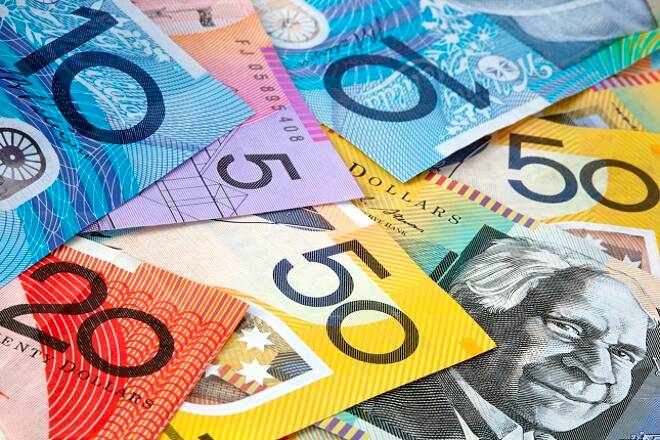Advertisement
Advertisement
Aussie Tumbles as Westpac Calls for Two Rate Cuts; BOJ Stands Ready to Ramp Up Stimulus if Necessary
By:
The week started with the minutes of the Reserve Bank of Australia Monetary Policy meeting showing that the central bank saw “significant uncertainties” in the economy as property values took a nosedive. There were no major reports out of New Zealand last week, but the Kiwi lost ground anyway in sympathy with the steep drop in the Australian Dollar. The Dollar/Yen was mostly rangebound last week, but still managed to close higher on the back of rising U.S. Treasury yields and increased demand for risky assets.
Volatility was the theme last week in the Asia/Pacific currencies especially in the Australian Dollar and New Zealand Dollar. Both saw major declines at one point last week on the daily charts, but by the end of the week, they had recovered most of their losses to finish only marginally lower. The Japanese Yen was mostly sideways, but still managed to eke out a small gain.
Australian Dollar
The week started with the minutes of the Reserve Bank of Australia Monetary Policy meeting showing that the central bank saw “significant uncertainties” in the economy as property values took a nosedive. This opened the door to future rate cuts.
Earlier in the month on February 6, RBA Governor Philip Lowe opened the door to a possible rate cut by acknowledging growing economic risks, in a surprise shift from its long-standing tightening bias.
Australian economic data was mixed last week with the Wage Price Index coming in at 0.5%, lower than the 0.6% forecast. The Employment Change showed the economy added 39.1K jobs in January. This was above the estimate. However, the previous month was revised lower to 16.9K. The Unemployment Rate came in unchanged at 5.0%.
The labor market data was actually supportive for the Aussie, but the currency plunged mid-week following reports that China banned coal imports from the country at a major port.
According to Reuters, customs at the Chinese port of Dalian has banned imported Australian coal since February, and will “cap overall coal imports from all sources to the end of 2019 at 12 million tonnes.” It also said that major posts elsewhere in China prolonged clearing times for Australian coal to at least 40 days. On Friday, the Aussie rebounded after Australian officials downplayed the impact of the ban.
In other bearish news, Westpac changed its interest rate forecast and now expects the Reserve Bank to deliver a 0.25 percentage point reduction to official interest rates in both August and November. That would trim the RBA’s official cash rate to just 1 percent.
Last week, the AUD/USD settled at .7128, down 0.0011 or -0.15%.
New Zealand Dollar
There were no major reports out of New Zealand last week, but the Kiwi lost ground anyway in sympathy with the steep drop in the Australian Dollar.
Minor reports showed the GDT Price index rising 0.9%. The previous week, it was up 6.7%. Credit Card Spending was up 6.9%, better than the previous month’s 4.5% reading.
A report on Producer Inflation was mixed. Quarterly PPI Input rose 1.6%, higher than the 1.0% estimate. The previous quarter showed an increase of 1.40%. Quarterly PPI Output was down 0.8%, below the 1.1% forecast and the 1.5% increase, reported last quarter.
Last week, the NZD/USD settled at .6850, down 0.0015 or -0.22%.
Japanese Yen
The Dollar/Yen was mostly rangebound last week, but still managed to close higher on the back of rising U.S. Treasury yields and increased demand for risky assets. The catalyst behind the moves were the U.S. Federal Reserve’s Monetary Policy Meeting Minutes, which showed a less-dovish central bank. Treasury traders thought the minutes indicated the Fed could raise rates at least once in 2019. Mixed U.S. economic data also pressured the Dollar/Yen at times.
Bank of Japan Governor Haruhiko Kuroda said early last week the central bank was ready to ramp up stimulus if sharp Yen rises hurt the economy and derail the path toward achieving its 2 percent inflation target.
Later in the week, Kuroda said the central bank would “of course” consider easing monetary policy further if the economy lost momentum toward achieving its 2 percent inflation target. It has various ways it could do this including cutting interest rates and accelerating government bond purchases, and it could combine such steps of needed.
“The BOJ will adopt policy that is most appropriate in light of economic and financial developments, and has the least side effects,” Kuroda said.
The USD/JPY settled at 110.669, up 0.203 or +0.18%.
About the Author
James Hyerczykauthor
James Hyerczyk is a U.S. based seasoned technical analyst and educator with over 40 years of experience in market analysis and trading, specializing in chart patterns and price movement. He is the author of two books on technical analysis and has a background in both futures and stock markets.
Advertisement
